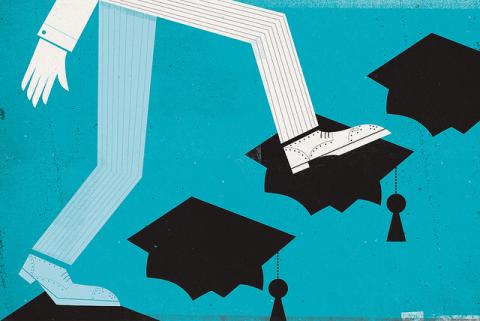Mizrahi-Ashkenazi Higher-education: Gaps Wider Than Ever
The figures in the study, entitled “Equal Opportunities in Education: Demographic and Socioeconomic Barriers,” show that even today the gaps in education between young Ashkenazim and Mizrahim, most of whom were born and studied in Israel, are far from disappearing. One of the reasons may be that the Education Ministry has never drawn up an orderly plan to address this situation.
The study, based on statistics compiled three years ago, focused on persons between the ages of 25 and 44. A further look at the data relating to Jewish ethnic origin reveals that the highest percentage of academic degree-holders is found among native Israelis whose father was born in Israel and whose mother is of Ashkenazi origin – 49.8 percent. This is closely followed by native-born Israelis whose immigrant parents were both of Ashkenazi origin – 49.6 percent. In third place are young people of Ashkenazi extraction who were born abroad – 46.2 percent. Among natives, one of whose parents was an immigrant of Ashkenazi origin and the other of Mizrahi origin, 45 percent have academic degrees. Further down on the list are native-born Israelis both of whose parents were born in this country, but whose ethnic origin is unknown – 35.3 percent; this is followed by immigrants from the former Soviet Union, who moved to Israel beginning in 1990, with 34.2 percent holding academic degrees.
Dramatic and disturbing
Lowest down on the list are two groups: Mizrahim, born in Asia and Africa – 31.4 percent of whom have academic degrees – and native Israelis whose parents are of Mizrahi origin – 28.8 percent. The latter is a dramatic and disturbing figure. These are young people who were born in Israel and therefore the education system is fully and absolutely “responsible” for them. Perhaps more than any other finding in the study, this constitutes the strongest evidence of the failure of local educational authorities to repair the gaps.
In recent years it seems that examination of such ethnic gaps, at least vis-a-vis the realm of education, has been receiving less attention from scholars than was the case 15 to 20 years ago. It is hard to isolate the reasons for this, but apparently they are related to problems related to research methods, which stem in large part from the CBS decision to keep track of citizens' ethnic origins for only one generation. In that sense, the latest study brings the so-called ethnic genie – which has been endlessly buried and eulogized – back to the forefront, at least in terms of research. In many other senses, in fact, it had never disappeared.
While Dobrin authored the study under the guidance of senior CBS officials, this is still not considered an official publication of the organization, and therefore “the opinions and conclusions expressed in it do not necessarily reflect those of the CBS,” as a disclaimer says at the beginning of the article.
Perhaps the relative freedom enjoyed by Dobrin led her to comment that the known connections between ethnic origin and socioeconomic background “do not absolve [the authorities] from the need to eliminate the ethnic connection," especially when the chances of success in the work place are linked to "upgrading human capital.” It is usually hard to find such wording in official CBS publications.
The source of Dobrin’s data is the Social Survey conducted by the CBS in 2011, which focused on Israelis' lifelong educational experiences. The survey enabled an examination of geographical, demographic and socioeconomic information related to the 20-something and above population, including the connection between parents’ education and that of their offspring. These figures are the most up-to-date available.
Although Dobrin’s study focuses on ethnic Jewish differences, occasionally the subject of the gap between Jews and Arabs crops up: The chances of the former to acquire a higher education are twice those of the latter; indeed, as of 2011 only 13 percent of Arabs held academic degrees.
Incomplete data
This study is, however, incomplete, according to Dobrin. Among other things, she notes that to provide a more complete picture of the economic and social barriers to higher education there is need for additional data, such as concerning the socioeconomic situation of the household that enabled or prevented acquisition of a degree, views regarding higher education and more. However, even if additional variables are found that affect the connection between ethnic origin and the chances of obtaining a university or college degree – they “will not reduce the serious problem posed by the ethnic factor,” she writes. It’s hard to compare these findings with previous studies. However, based on CBS census data, Prof. Yinon Cohen of Tel Aviv University and Columbia University found that, in 1995, about 36 percent of native Israelis of Ashkenazi origin (aged 25-34) had academic degrees, compared to 11 percent in the parallel Mizrahi group.
Or Kashti

